Supporting Your Birth Partner – Monthly Update
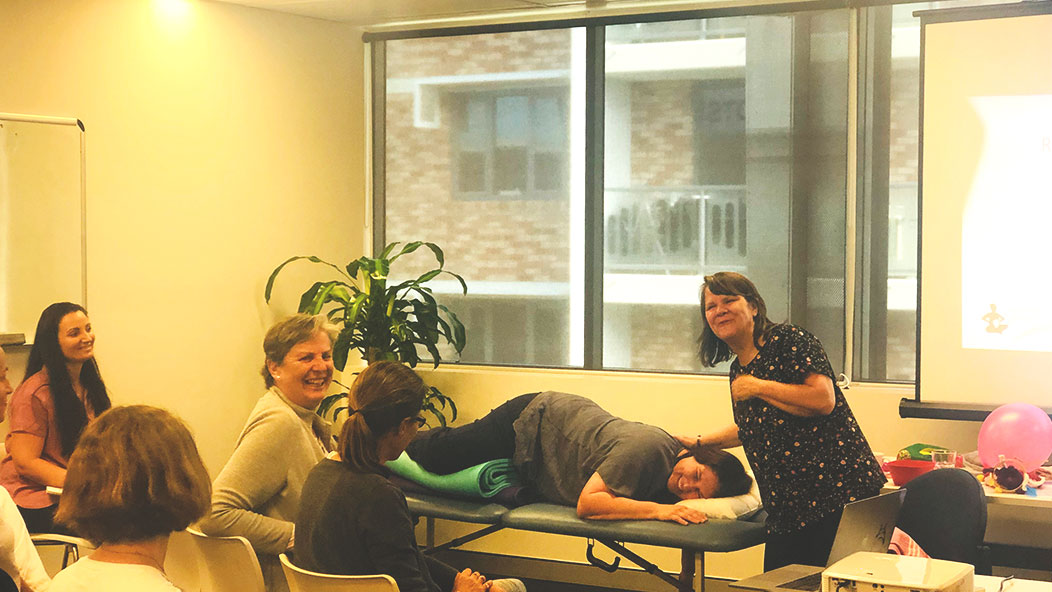
Halfway through pregnancy, 20 weeks, was a moment of satisfaction in my two pregnancies. I also looked eagerly toward the seventh month when an early birth could mean survival without serious risk of problems due to prematurity.
We have many projects gestating in Spinning Babies® that are feeling suddenly “viable!” Most will emerge by the end of the year: new Approved Trainers in August, a new website, and online learning options. At this time, they remain nestled inside the cozy womb of the office.
This month, we invite you to read a sweet birth story from doula Kate Dorsey comparing one mother’s two births—one before using Spinning Babies® and one after learning to prepare and ease birth with the Spinning Babies® approach. Hear about my time down under sharing the Spinning Babies® paradigm. And then let’s consider the partner’s role while remembering that family forms are fluid in our society.
Birth Story with Spinning Babies® from Doula Kate Dorsey
“My name is Kate, and I am a full-spectrum doula who attended one of your trainings in St. Louis a couple of years ago. I loved your methods, perspectives, and tools, but I hadn’t taken clients since then, so I had no idea how it would really work with pregnant people.
My friend Amy just had her second child last Friday, and I was lucky enough to be her doula for both of her births. The first was pre-Spinning Babies®, and the second was post-Spinning Babies®. This pregnancy she had been doing the daily exercises, experimented with different activities for bringing balance, and we watched your Parent Class together.
Not only was this birth the easiest I have ever attended, but it was also the fastest and she was the most comfortable with her body out of all my previous clients. She started laboring at 8 a.m., decided to head to the hospital at 1 p.m., and was admitted at 8 cm. She was getting great breaks between contractions and didn’t really start her “transition talk” until she was at the last hour before pushing. He was born at 4:15 p.m. perfectly healthy, and she only had a tiny tear in the same spot as an episiotomy during her previous birth.
Honestly though, some of my favorite gifts that you gave to this family were the ways that she was able to talk about where he was lying in her uterus, as well as about the symptoms of her labor and what that meant about his position, and the confidence that education and self-awareness gave her with her care providers.
One of her care providers told her that her back pain when he was descending through the pelvis could have been because he was OP, and we both looked at each other and shook our heads. She knew what back labor felt like and what an OP labor felt like and knew that her baby boy had not been OP during this labor! How cool is that?! We can’t thank you enough for the gift of a beautiful labor and self-confidence you gave to this family.” – Kate Dorsey
Kate’s friend Amy learned these skills and you can, too! Check out Belly Mapping® How kicks and wiggles reveal baby’s position.
Spinning Babies® in Australia
I (Gail Tully) just returned from a busy and meaningful tour of Australia, where I met with the midwives of Australia in seven workshops. Approved Trainers Fiona Hallinan and Jenny Blyth, event planner/doula Jo Askham, and Certified Parent Educator Trudy Vains created a dynamic support team!
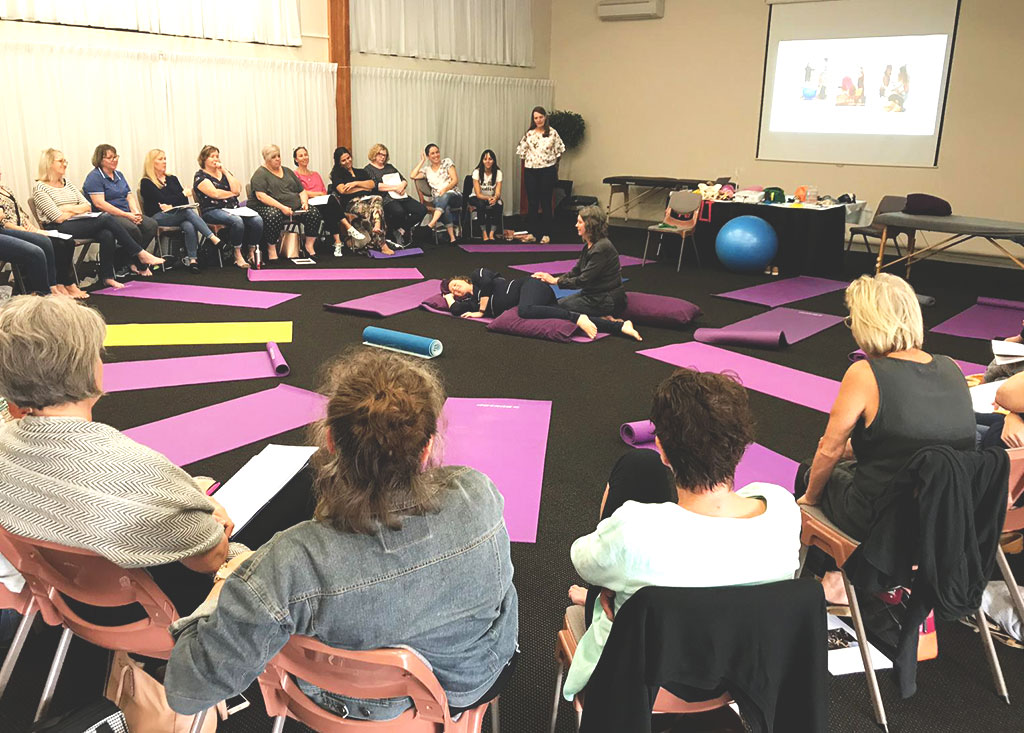
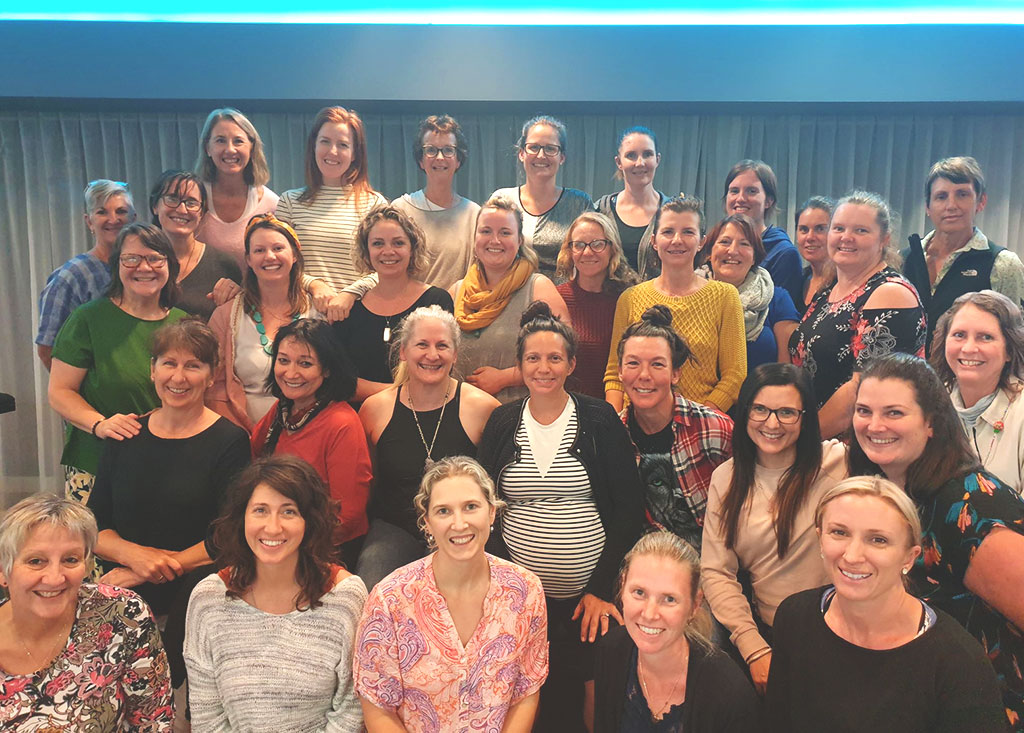
Birth workers in Australia are seeking the authentic Spinning Babies® Workshop.
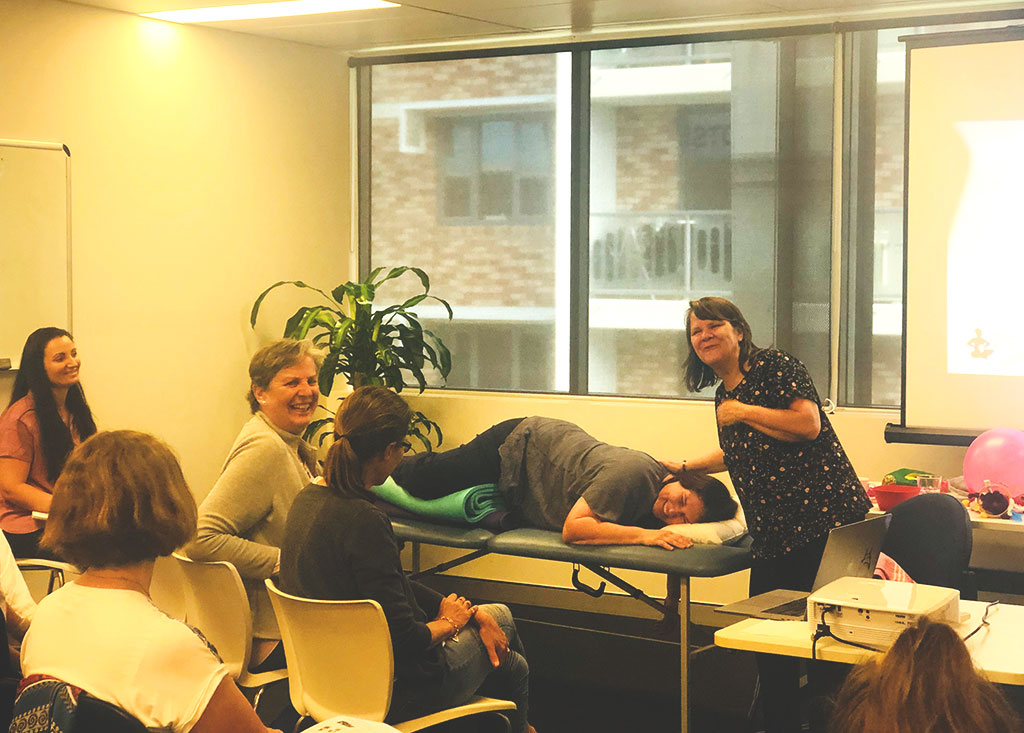
Birth Tip: Support Your Partner through Encouragement, Presence, and Patience
In the experience of birth, partners are having a child together, but only one person is doing the actual work of birth. This is the paradox of parenting in pregnancy and childbirth. Partners—the father, same-sex partner, co-parenting adult, family member or friend—navigate that their partner has the solo effort of giving birth also the need for social support. Social support is encouragement, presence, and patience to grow the bonds we call love, community, and family. Support your birth partner through:
1. Encouragement—Joy
Say out loud what makes you happy about the miracle of life! Almost every expectant parent is nervous about some aspect of parenting: Will we be able to afford a child? Will I be a good parent? Will I be able to support my partner the way they want to be supported? These and other questions are important. But instead of focusing only on worries, use your words to share your wonder and excitement with each other.
2. Presence—Physically and Emotionally Being There
Some parents are deployed, working, or detained far away. Whether in person or away, being present means acknowledging that the pregnant partner is going through a process of physical and emotional change and has many feelings, tasks, and questions. This is not a management position, but rather a skillful listening opportunity.
3. Patience—With Your Partner and with Yourself
Giving birth has many elements of change. Events like the timing or length of birth can’t be predicted or scheduled most of the time. Emotions and physical needs change and often need immediate attention. Take a breath and acknowledge what is happening in the moment. Pay attention to how your body is responding (breath, heart rate, temperature, and sensation). While it may feel like something needs to be resolved, that’s not always possible. Being patient can mean sharing with each other, doing something for each other, or simply acknowledging and accepting what is going on.
4. Spinning Babies® Techniques for Comfort
Spinning Babies® offers pregnant people and their partners several techniques for comfort for the pregnant person. When we are comforted, we are also calmed. Mental health, a pleasant mood, and a supple body might be more possible with some of the techniques we recommend.
The Jiggle (photo above) Sidelying Release, and Abdominal Release are relatively easy to learn and amazingly effective. Read the instructions out loud or have your pregnant partner read out loud, while you place your hands in position for the technique. You’ll earn lots of praise once you help your partner hack these techniques. You’ll both sleep better! Some are done every day, and some are twice a week.
Postpartum Support
After the baby arrives, support is important to set the family culture. Expect a high learning curve for the first couple of months for both of you. You’re learning a new world! Postpartum Support International is a source of Help for Moms and Resources for Dads. All partners and involved family members can find helpful information on how to support and cope during the postpartum time. From their website:
How to Help Mom
- Reassure her: this is not her fault; she is not alone; she will get better.
- Encourage her to talk about her feelings and listen without judgment.
- Help with housework before she asks you.
- Help her reach out to others for support and treatment.
For more tips, visit Postpartum.net.
Spinning Babies® Certified Parent Educator Training
Testimonial from an attendee:
“I am grateful, inspired, impressed after attending the Spinning Babies® training. We need so much here in Romania the gentle and non-invasive techniques you are teaching!
I like that your techniques are easy to learn, very useful and easy to apply in pregnancy and during labor, making birth safer for mother and baby. I like that Spinning Babies made me look more towards myself, towards ways to find my inner balance and be more connected to my body and that I’ve also learned to pass that to pregnant and birthing women. In my nature, and as a psychologist it’s easier for me to work with people’s minds, thoughts and emotions, so it’s been very useful for me to learn your physical techniques as I’ll need them to support better birthing women.
I also have to say I was most impressed by the relationships and the connection you built up in the training group, which is quite amazing in our context, considering that in our country relationships between birth professionals having different background and perspectives are very often tense. You showed us we can be a team! You are a true model, not only for your professional knowledge but also for your positive attitude, the joy, and love for birthing women!” – Ioana Markovits
Join the next Certified Parent Educator Training!
Is teaching expecting parents your passion? After your Spinning Babies® Workshop, were you inspired to share what you learned with expecting parents for more comfort in pregnancy and ease in birth? Join a growing group of Spinning Babies® Certified Parent Educators who are bringing this innovative and practical approach to their childbirth classes. Don’t miss the early bird price for our Certified Parent Educator Training .
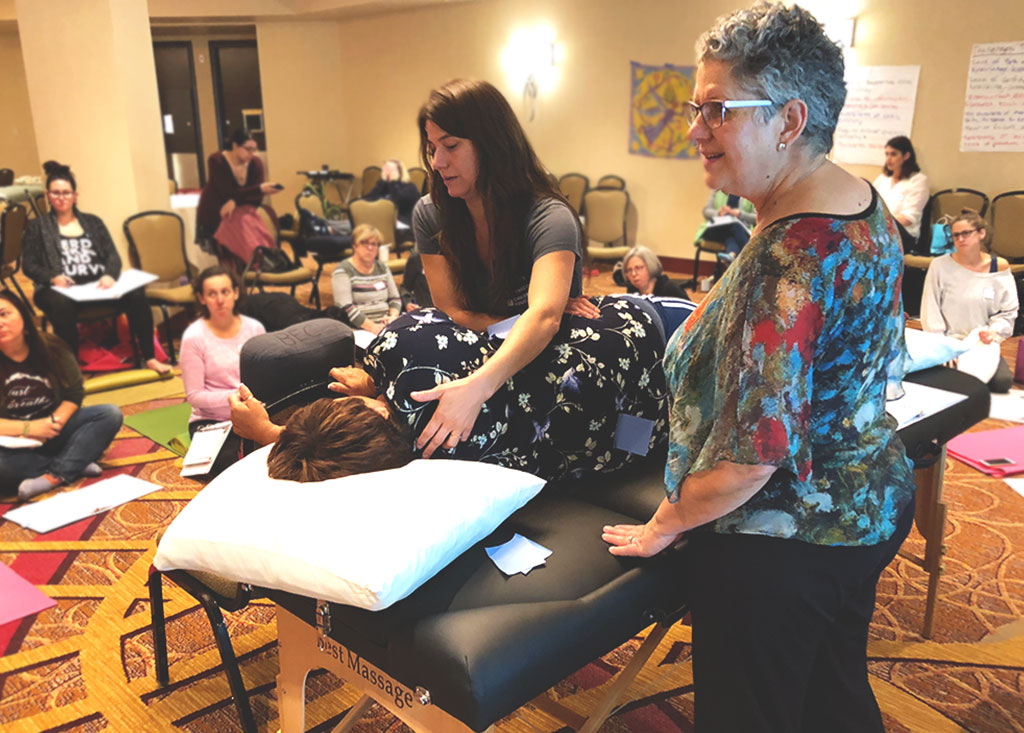
Nadine had this to say about her pregnancy experience with one of our SpBCPEs:
“Before attending class with Trudy, I had no idea that my pelvis was capable of so much! This was truly fascinating for me. I loved the 3 Sisters of Balance℠ [now 3 BalancesSM] and we practiced on a regular basis. My body was not coping with pregnancy very well, but after learning Side-lying Release that changed so much. I totally credit these things to the class as I had no idea at all what to expect. Baby was also spine-on-spine [posterior, sunny side-up] for quite a while during pregnancy and he flipped not long before labour started. I hope this helps to bring more awareness to the community about comfort for pregnancy and birth.”
Spinning Babies® Aware Practitioner Workshop
Watch for an upcoming Spinning Babies® Aware Practitioner Workshop. Midwives Rachel Shapiro, and Nicole Morales and massage therapist Jamie Mossay will lead expert education in the Spinning Babies® paradigm. Pregnancy bodyworkers, midwives, doctors, nurses, and physical therapists gain unique skills in fetal positioning. Hands-on training focuses on respectful, perceptive touch in pregnancy and birth. After attending this workshop, you can be listed on the Spinning Babies® Aware Practitioner Listing on our website.
Spinning Babies® in the Press
In Germany, Janni shares her story with “Gala,” a star gossip column online.
“Every birth is a way, and no two ways are ever the same. Each baby has the opportunity to find his way into the world through his own instincts, but we provide the framework for this: The space that represents the pelvis, and the uterus, as well as the space that we psychically in this special time for creating a new life. And because life is sometimes a movement, and sometimes a few millimeters can change everything, just as a single thought sometimes changes everything, means that you have to find this space and thoughts for yourself, by becoming aware of your own path goes, and dares to move there in the way that feels right for us.
“Peer and I have taken so much away from the ‘Spinning Babies®’ (Parent Class) today and found many great exercises and thoughts that we are now integrating into our everyday lives and that will remind us at the moment of birth that we are a team, and that—no matter which way it is—the most important is the love that accompanies us as a family that carries us and shows us the way…Melina told us a great deal about what the individual exercises do and how we can give our body even more space.”
In Australia, Cindy Lever writes about Spinning Babies® for Mamamia.com.au. Natalie wanted to avoid a cesarean but her baby was breech. Getting very active, she found the techniques which worked to give her baby room to turn.
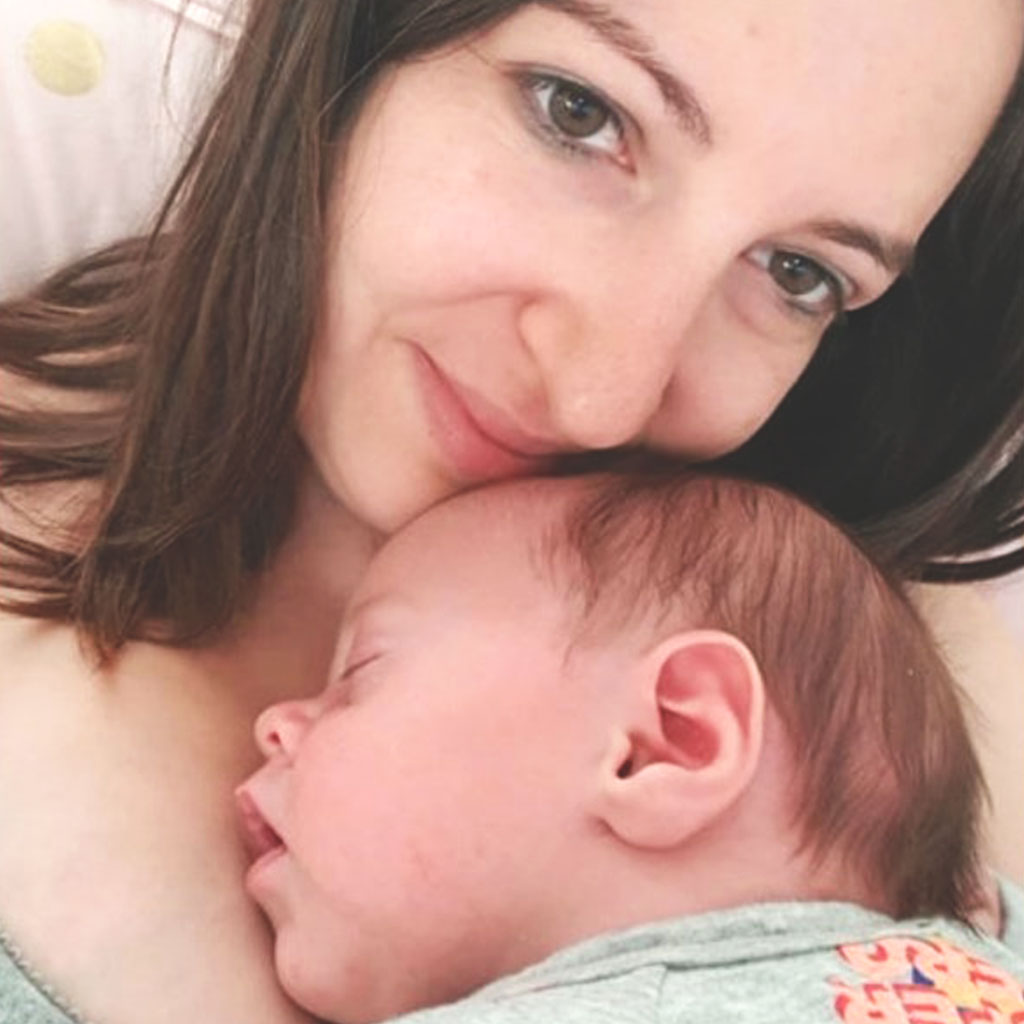
Natalie’s doula introduced her to Spinning Babies®. She used the body balancing techniques to allow her baby the room to move head down.
